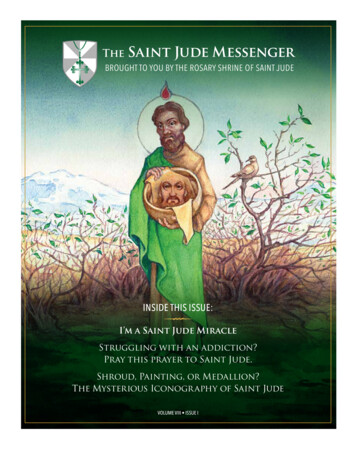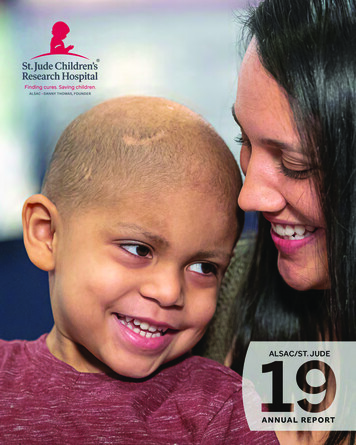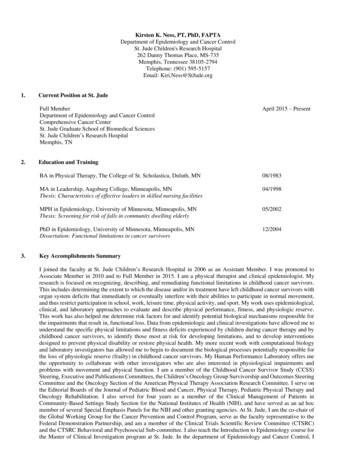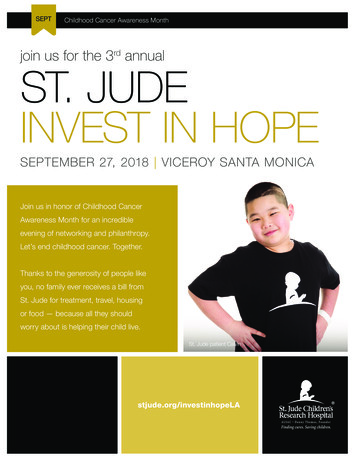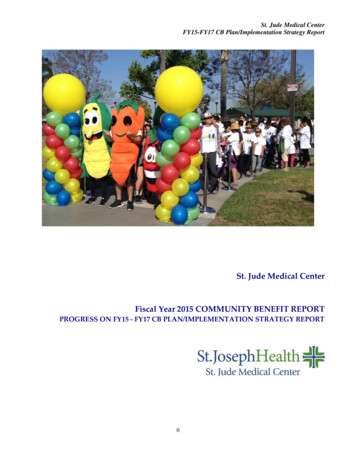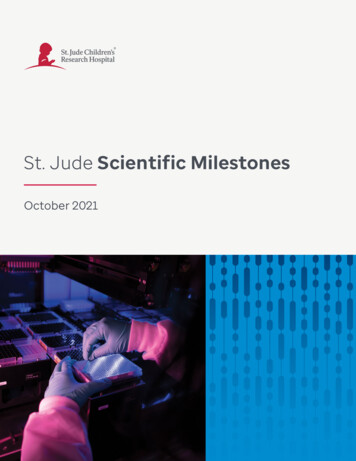
Transcription
St. Jude Scientific MilestonesOctober 2021
Table of Contents3Brain Tumors7Cell Cycle Biology10Gene Therapy13Human Immunodeficiency mia/Lymphoma36Pediatric Cancer Genome Project43Sickle Cell Disease48Solid Tumors54 St. Jude Global /Global Pediatric Medicine58Structural Biology61Survivorship2St. Jude Scientific Milestones
Brain TumorsBrain TumorsSt. Jude has a rich history of paradigm-shifting translational discovery,particularly in the field of brain tumor research. Our comprehensive research andcare teams have transformed the landscape of malignant diseases in children.St. Jude has led the field in adopting new research methodologies, embracingemerging technologies and optimizing clinical care.Brain tumor research and treatment began inearnest at St. Jude with the recruitment of thelate Larry Kun, MD. As founding director of theBrain Tumor Program, he united neurosurgeons,radiologists, pathologists, psychologists andnurses as one multidisciplinary team—all focusedon tackling this disease. Under Kun’s tenure, theprogram became one of the largest in the world,advancing our knowledge of brain tumors andtheir treatment.Radiotherapy is a critical component of anytreatment plan for pediatric brain tumor patients.St. Jude investigators were the first to adaptcomputer-based approaches to develop theearliest protocols for conformational radiationtherapy in a pediatric setting.In 2015, St. Jude opened the first proton beamtherapy center dedicated solely to children,St. Jude also recognized the vulnerability of thedeveloping brain to radiotherapy. The hospitalcontinues to spearhead efforts to minimize, delayor even eliminate radiation from clinical careplans. Investigators also leverage data from thelargest long-term follow-up study of pediatriccancer patients to help inform the development ofpreventative and palliative approaches.In 1995, Tom Curran, PhD, and Jim Morgan, PhD,established the Department of DevelopmentalNeurobiology, building world-class research inunderstanding mechanisms governing normalnervous system function and brain tumordevelopment. As technology evolved and ourunderstanding of the human genome improved,St. Jude took some of the earliest steps toinvestigate the molecular and genetic basis ofpediatric brain tumors. The work of scientistssuch as Tom Curran, PhD; Martine Roussel, PhD;Suzanne Baker, PhD; Paul Northcott, PhD; andRichard Gilbertson, MD, PhD, revealed nuances inbrain tumor biology that further refined diseaseclassification and improved our understanding ofpotential vulnerabilities.The discoveries of novel genetic mutations,altered signaling pathways, and dysfunctionalproteins facilitated the development of preclinicalmodels of disease and accelerated the clinicalpipeline. Clinical teams led by Amar Gajjar, MD;Giles Robinson, MD; Thomas Merchant, DO, PhD;and Santhosh Upadhyaya, MD, among others,are driving novel clinical protocols forward—incorporating genetic and molecular-basedpredictions, risk-stratification and targetedtherapies for patients from infancy toyoung adulthood.3St. Jude Scientific Milestones
Brain TumorsSt. Jude fosters collaboration and exchangefrom the laboratory bench to the patient bedside.Interdisciplinary teams of investigators, clinicians,bioinformaticians and chemistry experts in theNeurobiology and Brain Tumor Program engage invibrant exchange that creates a profound cycle ofdiscovery. Our pipelines are robust, anchored byaccurate model systems, sophisticated informaticsand analytics, and access to clinical materials andobservations that shape more research questions.As we enter the next phase of evolution for braintumor research and care, St. Jude continues toset the standard for excellence. We are workingto identify immunotherapeutic approaches forpediatric brain tumors, leverage technology toidentify vulnerabilities unique to these cancers,and optimize pharmacological interventions andenhance our understanding of disease origin byexploring normal brain development.St. Jude investigators are active participants inthe larger collaborative brain tumor researchcommunity. The Operations, Biostatistics and DataManagement Core of the Pediatric Brain TumorConsortium (PBTC) has been based at St. Judesince the founding of the consortium in 1999, and iscurrently led by Arzu Onar-Thomas, PhD. The PBTCPharmacokinetics Core is led by Clinton Stewart,PharmD, of St. Jude.4St. Jude Scientific Milestones
Brain TumorsBrain Tumor Milestones1984Larry Kun, MD, joins St. Jude and establishes the Brain Tumor Program.1985St. Jude enrolls its first brain tumor patients.1988Delay of radiation in young children is accomplished with chemo and surgery.(Jesse Jenkins, MD)1995Tom Curran, PhD, and Jim Morgan, PhD, establish the Department ofDevelopmental Neurobiology.1999The Pediatric Brain Tumor Consortium is founded.2001First measurements occur of radiation impact on the pediatric brain.(Thomas Merchant, DO, PhD; Grant Steen, PhD)2001Experimental models of medulloblastoma are established. Articles appear inCancer Research, 2001, 2003; Genes Development, 2005. (Tom Curran, PhD;Peter McKinnon, PhD; Martine Roussel, PhD)2004Scientists have conformational radiation treatment success in ependymoma.(Robert Sanford, MD; Thomas Merchant, DO, PhD)2004Targeted inhibition of sonic hedgehog pathway eliminates experimental models ofmedulloblastoma. (Tom Curran, PhD)2006Treatment improves survival for average-risk medulloblastoma patients to 85%,high risk to 70%.2006Subtypes of medulloblastoma are defined. (Richard Gilbertson, MD, PhD)2007Brain tumors originate from stem cells in vascular niches. (Richard Gilbertson, MD, PhD;Christopher Calabrese, PhD)2009First clinical trials of vismodegib, a sonic hedgehog pathway inhibitor, in medulloblastoma, isinitiated. Led by Amar Gajjar, MD, through the Pediatric Brain Tumor Consortium (PBTC-025,PBTC-025B, PBTC32).2010-11 Scientists complete a comprehensive genomic copy number analysis of pediatric high-gradegliomas and diffuse intrinsic pontine gliomas that reveals the most common alterations.Articles appear in Journal of Clinical Oncology, 2010; 2011. (Suzanne Baker, PhD)5St. Jude Scientific Milestones
Brain Tumors2010Pediatric Cancer Genome Project drives discovery of new mutations in DIPG, LGG, EPN andHGG, which alter classification of pediatric brain tumors and identify new candidate therapeutictargets. Articles are published in Nature Genetics, 2012; Nature, 2012; Nature Genetics, 2013;Nature, 2014; Nature Genetics, 2014. (Suzanne Baker, PhD; Richard Gilbertson, MD, PhD; DavidEllison, MD, PhD; Jinghui Zhang, PhD)2010Faithful experimental models of Group 3 medulloblastoma are developed. Papers are publishedin Cancer Research, 2010; Cancer Cell, 2012; Scientific Reports, 2018. (Martine Roussel, PhD)2012Mutational landscape of medulloblastoma is defined. (Richard Gilbertson, MD, PhD)2013St. Jude launches SJMB12 – a genomic-directed, risk-based clinical trial for medulloblastoma.2013-15 Vismodegib shows targeted efficacy against recurrent sonic hedgehog subgroupmedulloblastoma. Articles are published in Clinical Cancer Research, 2013; Journal of ClinicalOncology, 2015. (Giles Robinson, MD; Amar Gajjar, MD)2015First proton therapy center for children opens at St. Jude.2016David Ellison, MD, PhD, is among a team of eminent neuropathologists who update the WorldHealth Organization classification of central nervous system tumors to include mutations foundthrough the Pediatric Cancer Genome Project; Diffuse midline glioma, H3 K27M-mutant andRELA fusion-positive ependymoma.2018St. Jude announces the results of SJYC07 – a risk adapted clinical trial for infant brain tumors.(Giles Robinson, MD; Paul Northcott, PhD)2019 Preclinical modeling of craniospinal irradiation is optimized. Articles are published in theInternational Journal of Radiation Oncology, Biology, Physics, 2019 and CPT: Pharmacometrics &Systems Pharmacology, 2021. (Christopher Tinkle, MD, PhD; Clinton Stewart, PharmD)2020-21 A repository of PDOX models of pediatric brain tumors is established. Articles are publishedin Acta Neuropathologica, 2020; Nature Communications, 2021. (Martine Roussel, PhD;Suzanne Baker, PhD)2021 St. Jude enters a pediatric cancer-exclusive trial agreement with a major pharma companyfor atypical teratoid rhabdoid tumor (pending protocol development).2021New risk stratification for medulloblastoma trials is established. (Amar Gajjar, MD;Giles Robinson, MD; Paul Northcott, PhD)6St. Jude Scientific Milestones
Cell Cycle BiologyCell Cycle BiologySt. Jude has long been committed to promoting the basic sciences. In the early1980s, the hospital recruited cancer cell biologists Charles Sherr, MD, PhD, andMartine Roussel, PhD. As the first director of the Cancer Center’s MolecularOncology Program, Sherr was instrumental in recruiting scientists who changedthe nature of fundamental laboratory work conducted at St. Jude.Sherr and Roussel are credited with discoveringand cloning some of the earliest recognizedretroviral oncogenes. They went on todescribe their physiological functions in signaltransduction, regulation of gene expressionand cell cycle dynamics, as well as their rolein development and dysfunction. This earlywork laid essential groundwork for furtherinterrogation of disease mechanisms of pediatricleukemia and malignant brain tumors.The oncogenes and tumor suppressors identifiedand described by Sherr and Roussel haveemerged as popular candidates for geneticmanipulation and pharmacological targeting asa means of treating myriad pediatric and adultcancers. There are more than 200 ongoing orcurrently recruiting clinical trials investigatingthe therapeutic potential of these targetsidentified at St. Jude.SCIENTIFIC OVERVIEW OF ST. JUDECELL CYCLE DISCOVERIES:D-type cyclins convey extracellular signalsto intracellular machinery that controls cellcycle progression. They are induced by growthfactor stimulation and assemble with particularcyclin-dependent kinases (CDKs 4 and 6) tofacilitate entry into the DNA synthesis (S) phaseof the cell division cycle. Cyclin D-dependentCDK complexes selectively phosphorylatethe retinoblastoma protein (Rb) to regulatetranscription factors that play key roles incell proliferation and differentiation. CDK4/6activity is controlled in turn by the INK4 familyof proteins, creating a complex system ofregulation in which D-type cyclins and CDK4/6act as proto-oncogenes and Rb and INK4proteins serve as tumor suppressors.Disruption of the cyclin D-CDK4/6-INK4-Rbpathway by various molecular mechanismsoccurs commonly in many cancers. Selectiveinhibitors of CDK4/6, which block S phaseentry and chromosomal DNA replication, haveemerged as a promising therapeutic strategyfor cancer. Three CDK4/6 inhibitors (Palbociclib,IbranceTM /Pfizer, Abemaciclib, VerzenioTM/Lilly, and Ribociclib KisqaliTM/Novartis) wereapproved by the FDA for treatment of hormoneresponsive breast cancers and are currentlybeing applied in many other cancer types.7St. Jude Scientific Milestones
Cell Cycle BiologyCell Cycle Biology Milestones1983Charles Sherr and Martine Roussel open their laboratory at St. Jude.1985FMS oncoprotein is identified as a cell surface glycoprotein with tyrosine kinase activity.(Charles Sherr, MD, PhD; Martine Roussel, PhD)1985FMS proto-oncogene encodes the receptor for colony-stimulating factor 1 (CSF-1R).(Charles Sherr, MD, PhD; Martine Roussel, PhD)1987–88Mutations convert CSF-1R to an oncoprotein capable of transforming normal cells to cancer.Articles in Nature, 1987 and Cell, 1988. (Martine Roussel, PhD; Charles Sherr, MD, PhD)1991Myc is required for CSF-1R-induced cell proliferation. (Martine Roussel, PhD;Charles Sherr, MD, PhD)1991Scientists identify three novel D-type cyclins (D1, D2, D3) regulated by mitogenicgrowth factors. (Charles Sherr, MD, PhD; Martine Roussel, PhD)1992Researchers discover a novel cyclin-D-dependent kinase (CDK4) that selectivelyphosphorylates the retinoblastoma protein. (Charles Sherr, MD, PhD; Martine Roussel, PhD)1993–95Cyclin D/CDK4 complexes directly bind to and phosphorylate the retinoblastomaprotein to drive mitogen-dependent cell proliferation. Articles appear in Genes &Development, 1993, and Proceedings of the National Academy of Sciences, 1995.(Charles Sherr, MD, PhD; Martine Roussel, PhD)1994–99Scientists discover polypeptide CDK inhibitors that function in physiological settings wherecell cycle control is essential. Representative articles appear in Genes & Development, 1994;Molecular Cell Biology, 1995; EMBO, 1999; and Proceedings of the National Academy ofSciences, 1999. (Charles Sherr, MD, PhD)1995Researchers find that the INK4A tumor suppressor gene (CDKN2A) generates two distinct cellcycle inhibitory proteins, which include an unprecedented alternative reading frame protein(ARF). (Charles Sherr, MD, PhD)1996Mutations in the Rb pathway are identified as a hallmark of cancer cell cycles.(Charles Sherr, MD, PhD)1997–99The ARF tumor suppressor inhibits MDM2 to activate p53 and block cell cycle progression.Articles are published in Cell, 1997; Proceedings of the National Academy of Sciences, 1998;Nature Cell Biology, 1999. Charles Sherr, MD, PhD; Martine Roussel, PhD)8St. Jude Scientific Milestones
Cell Cycle Biology1999–2003The ARF-MDM2-p53 pathway monitors oncogenic signaling to suppress Myc-inducedlymphomagenesis and Ras tranformation. Articles appear in Genes & Development, 1999and Proceedings of the National Academy of Sciences, 2003. (Charles Sherr, MD, PhD;Martine Roussel, PhD) .2006–07N-Myc and CDK inhibitors control cerebellar development and are dysregulated inmedulloblastomas. Articles are published in Proceedings of the National Academy of Sciences,2006 and Cancer Research, 2007. (Martine Roussel, PhD; Charles Sherr, MD, PhD.)2018SJDAWN offers a phase 1 evaluation of CDK4/6i Ribociclib in combination therapies forpediatric brain tumors.2021Phase 1 trial PBTC-042 explores CDK4/6i Palbociclib for pediatric brain tumors.9St. Jude Scientific Milestones
Gene TherapyGene TherapyGene therapy pioneered at St. Jude has transformed the lives of peoplewith two debilitating diseases. Researchers are also moving toward clinicaltrials of gene therapy for treatment of sickle cell disease.The late Arthur Nienhuis, MD, launched theSt. Jude gene therapy program after he becamethe hospital’s fourth director in 1993. Nienhuiswas an established gene therapy investigator,whose basic and early clinical studies involvedengineering viral vectors to modify hematopoieticstem cells for the treatment of blood disorders.HEMOPHILIA BIn a 2011 landmark paper published in theNew England Journal of Medicine, researchersreported that gene therapy developed at St. Jude,University College London and Royal Free Hospitalwas safe and effective for treatment of severehemophilia B. The gene therapy for the inheritedbleeding disorder was produced at the Children’sGMP on the St. Jude campus, using a system thatimproved production.In a 2014 follow-up study, researchers reportedthat the gene therapy provided long-term relief to10 men with severe hemophilia B patients treatedin Memphis and London. The findings appeared inthe New England Journal of Medicine.Currently, in low- and middle-income countries,children with Factor IX deficiency, a form ofhemophilia, receive minimal treatment. Manyof these children die in early adulthood. As partof the FY2022–27 St. Jude Strategic Plan, anupcoming clinical trial will focus on determiningwhether gene therapy for Factor IX deficiencycan be implemented in low- and middle-incomecountries. Proof that a gene therapy approachcould be implemented within these settingswould be a landmark in medicine and might spur aconcerted worldwide effort to advance this kind oftherapeutic approach.SCID-X1X-linked severe combined immunodeficiency(SCID-X1, or bubble boy disease) is a rare, lifethreatening genetic disorder. The disease is causedby a mutation in the interleukin-2 receptor subunitgamma (IL2RG) gene that produces a proteinessential for normal immune function. Children withthe mutation are born without functional immunesystems. They lack the ability to produce T cells ornatural killer (NK) cells; and although they have anormal number of B cells, they are not functional.Various SCID-X1 gene therapy clinical trials havebeen conducted over 20 years, both as an alternativeto hematopoietic stem cell transplant or followinga poor outcome. In early trials conducted at otherinstitutions, transduction of normal copies of themutated IL2RG gene into hematopoietic stemcells using a gamma- retroviral vector previouslyresulted in reconstitution of patient NK and T cells,but not functional B cells. Moreover, vector-inducedleukemia occurred in 25% of patients due to insertionof the gene-carrying retrovirus near an oncogene.A lentiviral vector developed and produced atSt. Jude in collaboration with investigators atthe National Institutes of Health was used in aclinical trial at the National Institute of Allergyand Infectious Diseases. The study included five10St. Jude Scientific Milestones
Gene Therapyadolescent and young adult patients with SCID-X1with declining immune function, chronic viralinfections and other SCID-XI health problems.As infants, the patients had all undergonehematopoietic stem transplant with parentaldonors. More than two years after undergoing theSt. Jude gene therapy, the patients experiencedmarked clinical improvement and enhancedproduction of immune cells, including T, B andnatural killer cells.In a 2019 study published in the New EnglandJournal of Medicine, in collaboration withinvestigators at the NIH and UCSF, the St. Judegene therapy vector cured eight infants withSCID-X1. Following gene therapy, the childrenproduced functional immune cells, includingT cells, B cells and NK cells, for the first time. Astoddlers, the patients responded to vaccinationsand were living normally. This landmark paperdescribes, for the first time, the use of low-dosebusulfan to facilitate engraftment of correctedstem cells in infants.The trials continue, with those under the age of 2being treated at St. Jude, UCSF Benioff Children’sHospital, and Seattle Children’s Hospital; and olderpatients being treated at the National Institutesof Health. In 2018, the trials resulted in an exclusiveworldwide license agreement between St. Jude andthe pharmaceutical company Mustang Bio to furtherdevelop and commercialize SCID-X1 gene therapy.SICKLE CELL DISEASEAs outlined in the sickle cell disease section of thisScientific Milestones report, St. Jude investigatorshave made significant contributions to the clinicalcare of patients with this devastating disease. Toadvance cures for individuals with sickle cell disease,Mitchell Weiss, MD, PhD, and his team demonstratedin preclinical studies that genome editing of HBG1and HBG2 in hematopoietic stem cells inducesfetal hemoglobin for the treatment of sickle celldisease and beta thalassemia. Likewise, Weiss andhis collaborators at the Broad Institute of Harvardand MIT have demonstrated that base editing ofhematopoietic stem cells rescues sickle cell diseasein patient-derived stem cells and in mice.Based on these encouraging findings, members ofthe Departments of Hematology and Bone MarrowTransplantation and Cellular Therapy, led by Weissand Gottschalk, are developing an early phaseclinical study to evaluate the safety and efficacy ofgenome editing of HBG1 and HBG2 in patients withsickle cell disease.11St. Jude Scientific Milestones
Gene TherapyGene Therapy Milestones1993Arthur Nienhuis, MD, establishes experimental hematology program with a focus on developinggene therapy for blood disorders.1998In a first, St. Jude researchers use gene therapy to cure severe combined immunodeficiency (SCID)in an animal model. (Brian Sorrentino, MD)2009St. Jude researchers and colleagues develop a self-inactivating lentiviral vector based on the HIVvirus to make SCID-X1 gene therapy safer and more effective. Investigators also streamline vectorproduction. (John Gray, PhD; Brian Sorrentino, MD)2011St. Jude announces that after adenovirus-associated virus vector–mediated gene transfer inhemophilia B, four of six subjects have discontinued FIX prophylaxis and remain free of spontaneoushemorrhage; in the other two, the interval between prophylactic injections has increased. (AndrewDavidoff, MD)2011The New York Times calls hemophilia B discovery a landmark achievement.2011St. Jude GMP produces self-complementary serotype 8 adeno-associated viral vector for ahemophilia B clinical trial. The material is approved for use in clinical trials in the United States andthe United Kingdom. (John Gray, PhD; James Allay, PhD)2014Scientists report long-term safety and efficacy of Factor IX gene therapy in hemophilia B.(Andrew Davidoff, MD)2016Investigators at St. Jude and the NIH announce lentiviral hematopoietic stem cell gene therapy forX-linked severe combined immunodeficiency. (Brian Sorrentino, MD)2016CRISPR gene editing reveals new therapeutic approach for blood disorders, including sickle celldisease and beta thalassemia. (Mitchell, Weiss, MD, PhD)2019Investigators at St. Jude and UCSF Benioff Children’s Hospital San Francisco use noveltreatment that combines gene therapy and low-dose chemotherapy with busulfan to restorecomplete immune function in infants newly diagnosed with SCID-X1. (Brian Sorrentino, MD;Ewelina Mamcarz, MD)2019Genome editing of HBG1 and HBG2 hematopoietic stem cells induces fetal hemoglobin for thetreatment of sickle cell disease and beta thalassemia. (Mitchell, Weiss, MD, PhD)2019Gene therapy for X-linked SCID wins the 2019 Smithsonian Magazine American Ingenuity Award.(Ewelina Mamcarz, MD; Stephen Gottschalk, MD)2021Investigators at St. Jude, the Broad Institute of Harvard and MIT demonstrate that base editingof hematopoietic stem cells rescues sickle cell disease in patient-derived stem cells and in mice.(Mitchell, Weiss, MD, PhD)12St. Jude Scientific Milestones
Human Immunodeficiency Virus (HIV/AIDS)Human Immunodeficiency Virus (HIV/AIDS)In 1987, St. Jude founder Danny Thomas declared AIDS a catastrophic disease ofchildren. It was then that HIV/AIDS became a research priority of St. Jude.Since that time, the St. Jude Department ofInfectious Diseases has developed a broad,multidisciplinary pediatric program called thePediatric AIDS Clinical Trials Unit (PACTU), whichin 1999 was designated a Center of Excellenceby the Robert Wood Johnson Foundation. As aNational Institutes of Health Pediatric AIDS ClinicalTrials Unit, St. Jude participated in a nationallandmark study that showed chemotherapyreduced the risk of HIV transmission frominfected women to their babies. Clinical careand prevention efforts continue.But the hospital’s contribution to HIV/AIDStreatment began decades earlier. In 1973, WalterHughes, MD, Infectious Diseases Departmentchair, led research that identified Pneumocystispneumonia (PCP) as a life-threatening infectionin pediatric cancer patients, primarily childrenwith acute lymphoblastic leukemia. PCP is causedby the fungus Pneumocystis jirovecii. Hughes andhis colleagues found that about 20% of pediatriccancer patients contracted the fungus.In 1977, the New England Journal of Medicinepublished research from Hughes and his colleaguesthat showed the drug combination of trimethoprimand sulfamethoxazole (TMP-SMX) was highlyeffective for PCP prevention and treatment.Prior to the HIV/AIDS epidemic, the infectionwas diagnosed mainly in immunocompromisedindividuals, including cancer patients. In 1981, PCPwas the first opportunistic infection identified inpatients with HIV/AIDS. Hughes played an importantrole in establishing the TMP-SMX was also effectiveat preventing PCP in AIDS patients. He led additionalresearch into PCP prevention and treatment inpatients with HIV/AIDS. Today TMP-SMX remains themost commonly used drug to prevent or treat PCP inpatients with AIDS.In 2021, St. Jude launched End HIV 901—a federallyfunded project that aims to end new HIV infectionsin Memphis by 2030. New HIV infection rates continueto remain high in the Black community, with 84%of new infections occurring among the Blackpopulation. Males and young adults aged 15–34years comprise the other groups that have seenincreased infection rates.13St. Jude Scientific Milestones
Human Immunodeficiency Virus (HIV/AIDS)HIV/AIDS Milestones1973Scientists report on pneumocystis carinii pneumonitis in children with malignancies.(Walter Hughes, MD)1977St. Jude discovers that trimethoprim–sulfamethoxazole is a successful chemoprophylaxis forpneumocystis carinii pneumonitis (PCP). (Stephen George, PhD; Walter Hughes, MD)1977TMP-SMX is found to be effective in cancer patients who are at a high risk of PCP. (Charles Pratt,MD; Walter Hughes, MD)1981CDC publishes findings on pneumocystis and HIV.1987Danny Thomas declares AIDS a catastrophic disease of children.1992U.S. Public Health Service announces that Walter Hughes, MD, is part of a task force onPCP prevention in HIV/AIDS patients.1992The National Institutes of Health names St. Jude as a Pediatric AIDS Clinical Trials (PACTG) site.1993Scientists find that for the treatment of P. carinii pneumonia, atovaquone is less effectivethan trimethoprim-sulfamethoxazole, but it has fewer treatment-limiting adverse effects.(Walter Hughes, MD)1994PACTG publishes a paper on reduction of maternal-infant transmission of humanimmunodeficiency virus type 1 with zidovudine treatment.1997St. Jude is redesignated as an NIH Pediatric AIDS Clinical Trials (PACTG) site.1997St. Jude is designated as an Adolescent HIV/AIDS Clinical site by the National Institute of ChildHealth and Human Development (NICHD).2004PACTG publishes its first studies in adolescents treated with antiretroviral therapydemonstrating suboptimal outcome mostly due to medication adherence.2005NICHD designates St. Jude as a Pediatric HIV/AIDS Cohort study site.2006NICHD names St. Jude as an Adolescent Trials Unit Clinical (ATN) site, with redesignation in 2011.2006St. Jude is redesignated as a NIH Pediatric Clinical Trials/International Maternal, Pediatric andAdolescent Clinical Trials site (IMPAACT), with subsequent redesignations in 2014 and 2021.2016St. Jude is named a clinical trials site for an HIV Prevention Trials Network (HPTN) studycomparing long-acting injectable to oral medications for pre-exposure prevention (PrEP)of HIV in young men.14St. Jude Scientific Milestones
Human Immunodeficiency Virus (HIV/AIDS)2021CDC announces that TMP-SMX is the most commonly used drug for pneumocystis pneumonia.2021The End HIV 901 project launches to end new HIV infections in Memphis by 2030.2021HPTN publishes results of the HPTN 083 study demonstrating superiority of long-actinginjectable PrEP for HIV prevention in young men.15St. Jude Scientific Milestones
ImmunologyImmunologyUnderstanding the immune system is critical for making progress in thetreatment of diseases from cancer to infections. The St. Jude Department ofImmunology has a robust history of scientific discovery. In fact, Peter Doherty,PhD, was awarded the Nobel Prize for research on the biological basis of organrejection following transplantation. The immunology department continues tolead groundbreaking research that reveals how the immune system works andhow it can be harnessed to fight disease.UNDERSTANDING ORGAN REJECTIONIn 1996, Peter Doherty, PhD, shared the Nobel Prizein Physiology or Medicine with Rolf Zinkernagel,MD, PhD, of the University of Zurich. Theresearchers were awarded the Nobel in recognitionof their discoveries into how the immune systemrecognizes and responds to virus-infected cells.The award honored research conducted in theearly 1970s when they were young researchersworking together.Their work explained how white blood cells calledT lymphocytes recognize and destroy virusinfected cells. They proposed that T-cellsrecognize and respond when a piece of virus, oranother “foreign” agent, combines and is carriedto the cell surface by a protein called the majorhistocompatibility complex. Now emeritus faculty,during the height of his career at St. Jude, Dohertycontinued his investigations into cell-mediatedimmunity, T cell recognition and immune memory.CELL DEATH AND SURVIVAL MECHANISMSIn the human body, cells come equipped witha self-destruct mechanism. But apoptosis, theprocess cells use to disassemble and recycle theirparts, is a complex phenomenon. For diseased cells,when therapies aimed at their destruction don’twork, researchers have looked at apoptosis andother cell death mechanisms to better understandhow and why these cells persist.Chair of the St. Jude Department of Immunology,Douglas Green, PhD, focuses on the processes ofcell death and cell survival, extending from therole of cell death in cancer regulation and immuneresponses to the molecular events directing thedeath of the cell. In 2020, Green was elected to theNational Academy of Sciences in recognition ofthis work.INFLAMMASOMESInflammasomes are multi-protein complexesthat form in damaged or infected cells to driveinflammation and programmed cell death. Theterm was coined in 2002, and inflammasomes arenow a major focus of immunology research andtherapeutic innovation.Thirumala-Devi Kanneganti, PhD, vice chair of theSt. Jude Immunology Department, is a foundingmember of the field. In 2006, she provided thefirst genetic evidence for the role of the NLRP3protein in inflammasome activation, and she hascontinued to establish its importance in infection,inflammation, and cancer.16St. Jude Scientific Milestones
ImmunologyKanneganti’s research on master regulatorsof inflammasome activation led to herpioneering the concept of PANoptosis, whichis defined as a unique physiologically relevant,inflammatory programmed cell deathpathway regulated by the PANoptosomecomplex. The PANoptosome provides amolecular scaffold for
St. Jude Scientific Milestones 5 Brain Tumors 1984 Larry Kun, MD, joins St. Jude and establishes the Brain Tumor Program. 1985 St. Jude enrolls its first brain tumor patients. 1988 Delay of radiation in young children is accomplished with chemo and surgery. (Jesse Jenkins, MD) 1995 Tom Curran, PhD, and Jim Morgan, PhD, establish the Department of .
